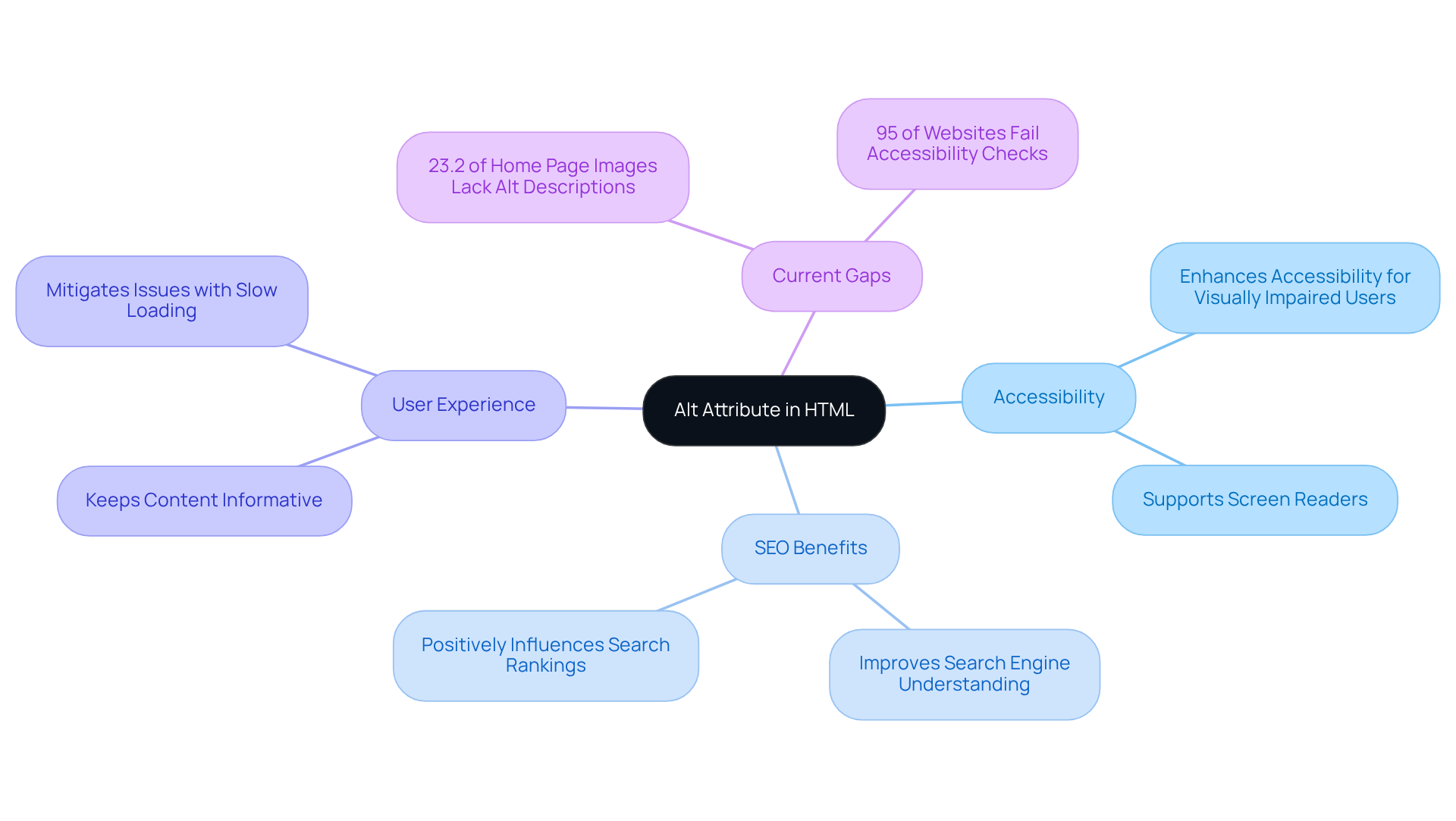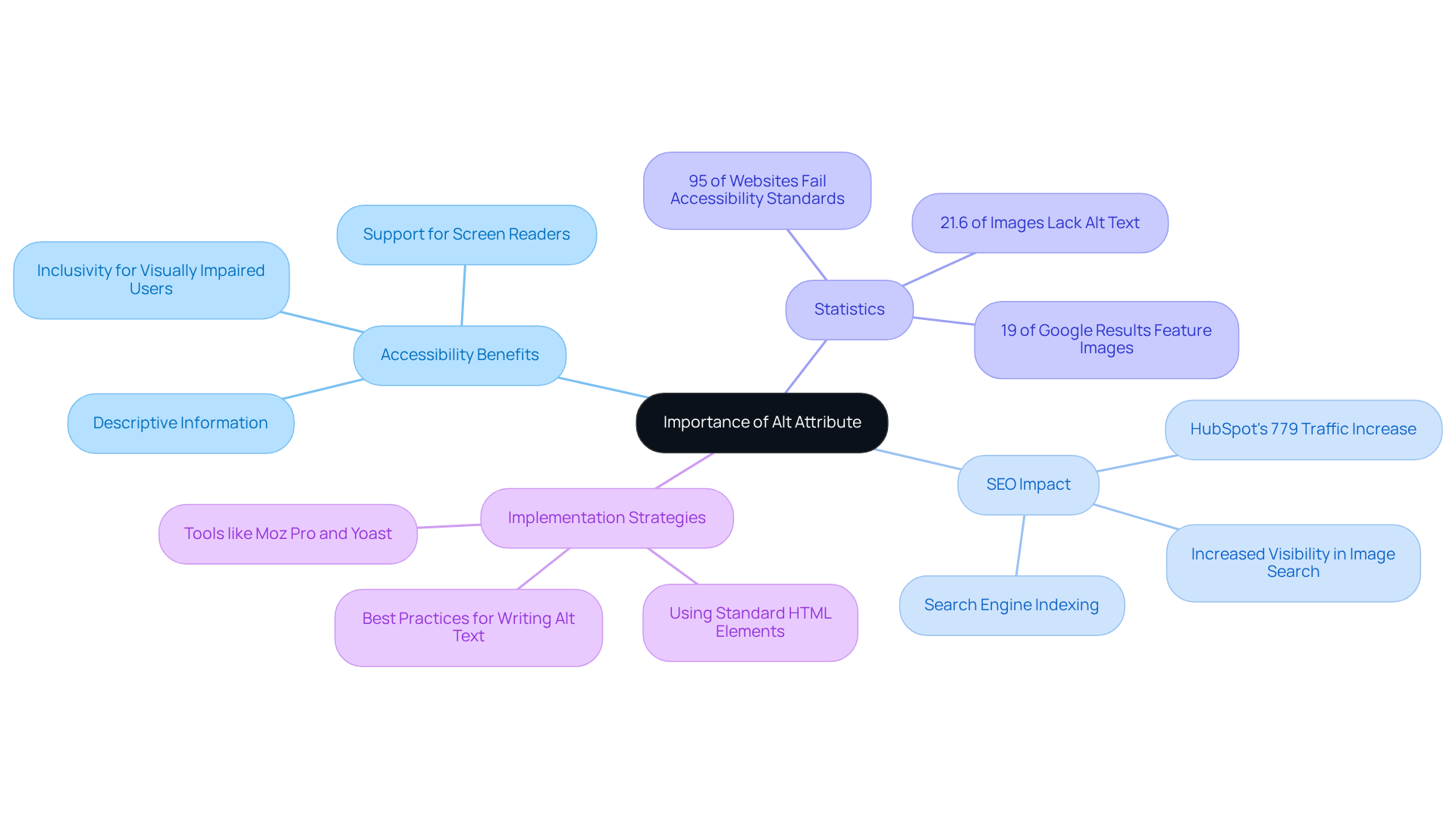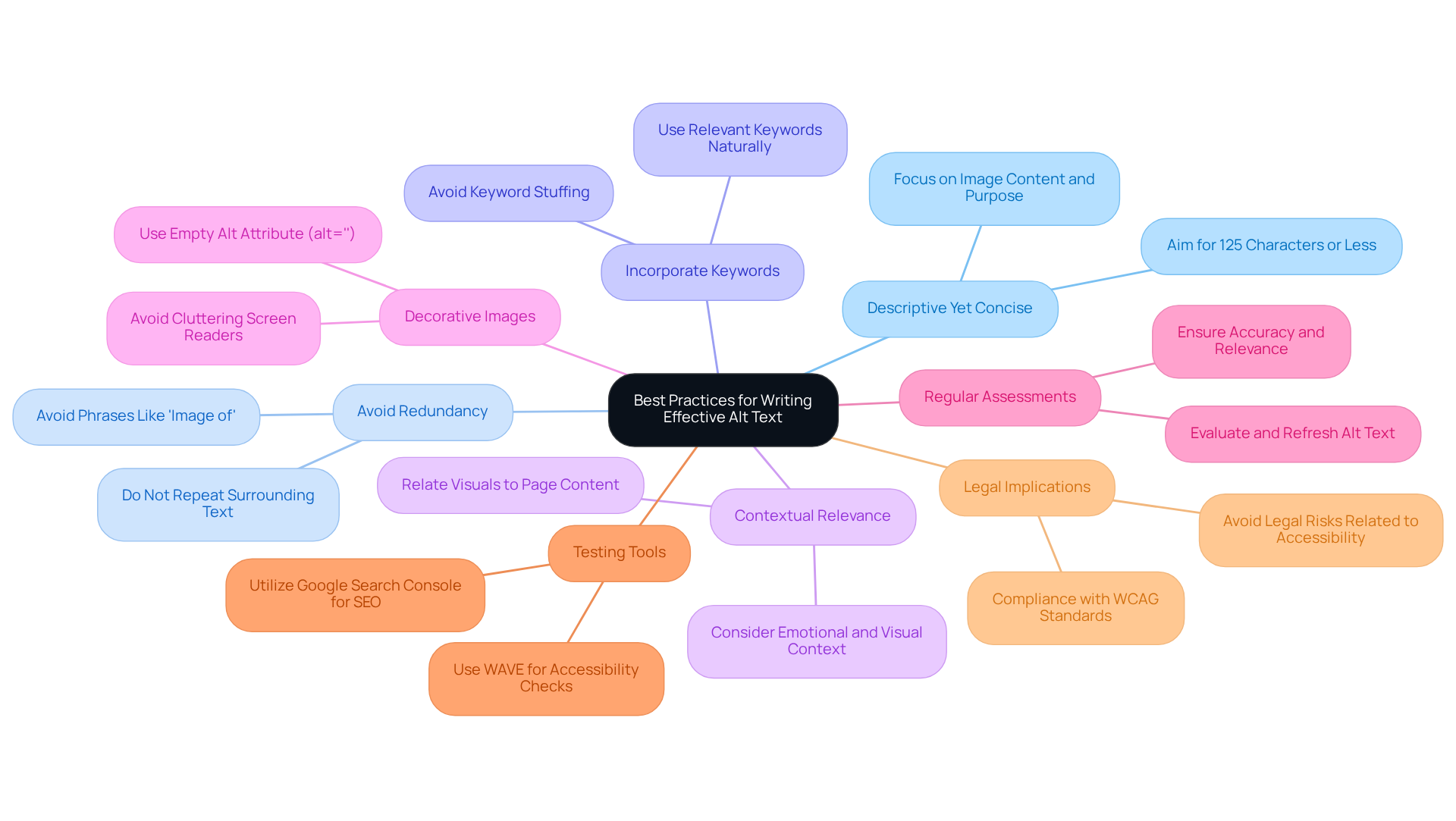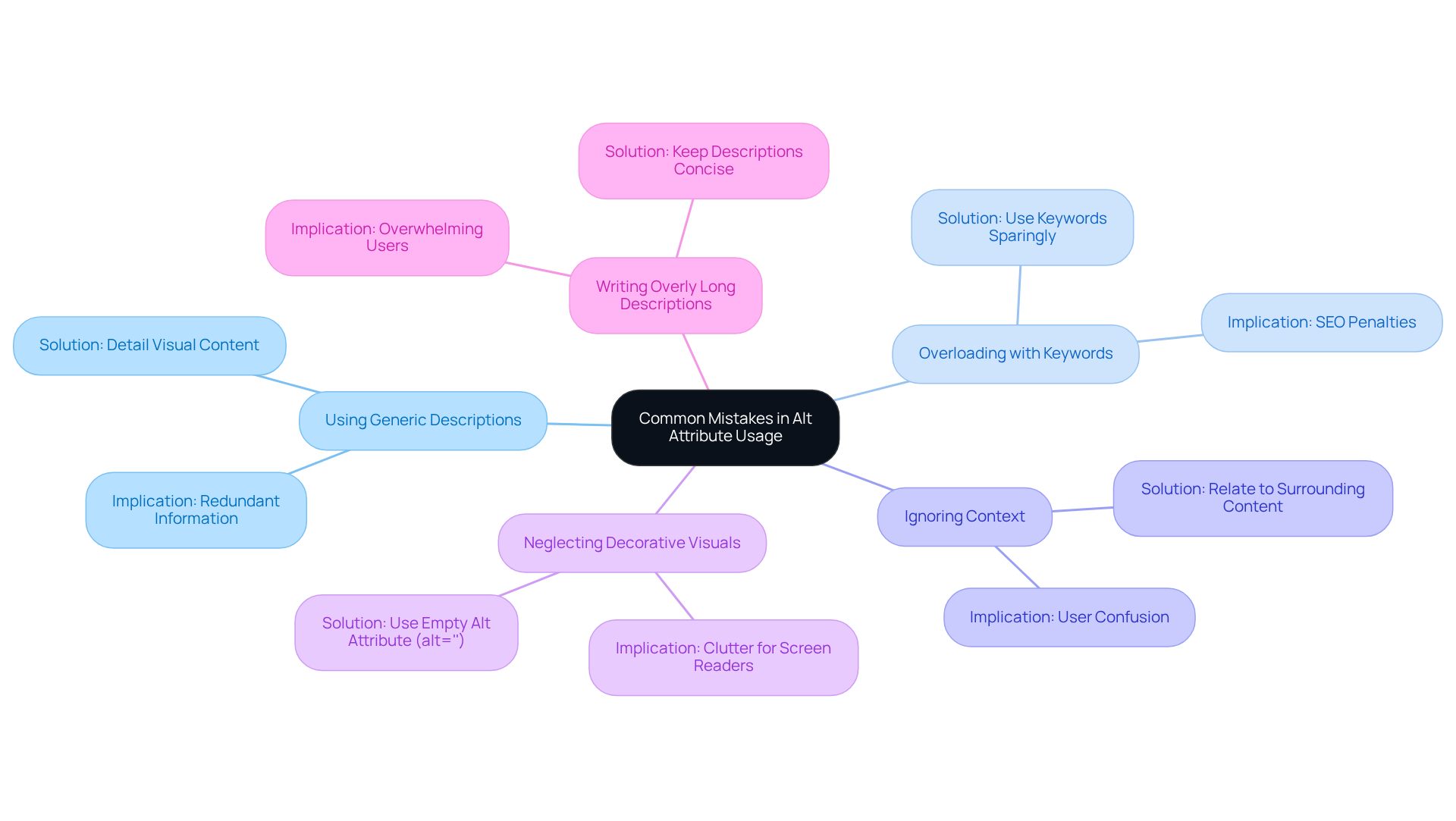Overview
The alt attribute, or alternative text, presents a significant challenge in the realm of web accessibility and SEO. Many users, particularly those who rely on screen readers, struggle to access visual content effectively. This not only limits their experience but also affects how search engines interpret and rank websites. The implications of neglecting this essential element can be profound, as it excludes a segment of users and diminishes visibility in search results.
However, there is a nurturing solution. By implementing effective alt text, we can foster inclusivity for visually impaired users while simultaneously enhancing our search engine rankings. This approach not only supports a diverse audience but also elevates our digital strategy, ensuring that everyone can engage with our content. Embracing this practice is not just a technical requirement; it's a compassionate step towards creating a more accessible online environment for all.
Introduction
In today's digital landscape, understanding the nuances of web accessibility and search engine optimization is becoming increasingly crucial. A central element of this conversation is the alt attribute—a simple yet powerful HTML component that enhances user experience for visually impaired individuals and boosts a website's visibility in search engine results.
Sadly, many web developers overlook its proper implementation, leading to missed opportunities for inclusivity and SEO success. This oversight not only affects those who rely on accessibility features but also diminishes the potential reach of businesses online.
How can we, as a community, ensure that we are effectively utilizing alt attributes? By embracing these practices, we can comply with accessibility standards while also improving our online presence. Together, we can foster a more inclusive digital environment that benefits everyone.
Define Alt Attribute: Understanding Its Role in HTML
The alt property, or 'alternative text,' is a vital HTML element within the <img> tag that helps to explain what is alt attribute by providing a textual description of an image. This description appears when the visual cannot be displayed, whether due to a slow internet connection or when a user relies on a screen reader. The alt property plays several crucial roles:
- It enhances accessibility for visually impaired individuals.
- It offers context for search engines.
- It improves the overall user experience by ensuring that content remains informative, even when visuals fail to load.
For instance, consider a picture of a dog; the alt text might read alt='Golden Retriever playing in the park', effectively conveying essential information about the image's content. Unfortunately, statistics reveal that approximately 23.2% of all home page visuals , highlighting a significant gap in web accessibility practices. This oversight not only affects users but can also expose businesses to potential legal actions, including lawsuits and demand letters.
By correctly applying what is alt attribute, we can support users with disabilities while also enhancing SEO outcomes, as search engines utilize this text to understand the content of images. In fact, accessible websites positively influence search engine rankings, making it even more crucial for businesses to prioritize the use of alt text. Moreover, research shows that 51% of consumers are willing to pay more for products or services from businesses that prioritize web accessibility. Therefore, incorporating detailed alt tags is not just a technical requirement; it is a fundamental step towards creating an inclusive and effective digital environment that resonates with everyone.

Explain the Importance of Alt Attribute in Accessibility and SEO
What is alt attribute, and why does it play a vital role in web accessibility by providing descriptive information for visuals that screen readers can interpret? This functionality is essential for ensuring that visually impaired users can fully engage with webpage content, fostering a sense of inclusivity that we all strive for.
When we consider the perspective of like Google, it becomes clear that alternative descriptions are crucial for cataloging visuals and understanding the context of surrounding content. It's important to recognize that search engines are not yet able to comprehend visuals with complete accuracy, highlighting what is alt attribute as a necessity for effective alternative descriptions.
Understanding what is alt attribute is essential, as well-optimized alt attributes not only enhance a website's search engine rankings but also improve the likelihood of appearing in visual search results, significantly boosting site traffic. For instance, nearly 19% of Google's search results feature visuals, highlighting the visibility benefits of utilizing alt tags.
HubSpot's focused approach to enhancing alt attributes led to an impressive 779% increase in visual traffic within a year, resulting in an additional 160,000 organic views. This demonstrates what is alt attribute and how impactful they can be in directly influencing a website's visibility and user engagement, making them an essential element of any digital strategy.
Furthermore, employing standard HTML picture elements assists crawlers in locating and processing visuals, while tools like Moz Pro Site Crawl and Yoast SEO can effectively enhance alt descriptions. Together, these strategies not only support accessibility but also contribute to a more inclusive online experience for everyone.

Outline Best Practices for Writing Effective Alt Text
Creating effective alternative descriptions can feel overwhelming, especially when considering what is alt attribute and its significance for accessibility and search engine optimization. It’s crucial to be descriptive yet concise; aim for a brief description that captures the essence of the image without unnecessary verbosity. This not only helps users but also enhances your visibility online. Avoid redundancy by refraining from repeating information already present in the surrounding content. Incorporating relevant keywords naturally can boost your SEO, but be mindful to steer clear of keyword stuffing. Remember, understanding what is alt attribute is a ranking factor for Google Image Search, so optimizing it is essential for your success.
Focusing on context is vital; relate the visual to the page's content to enhance the user experience. For purely decorative images, consider using an empty alt attribute (alt='') to keep screen readers free from irrelevant information. It’s also important to consistently assess and refresh your alternative descriptions. Regular evaluations ensure that your descriptions remain accurate and pertinent.
Utilizing can assist you in evaluating and enhancing your alt description for both accessibility and SEO. Lastly, be aware of the legal implications; not including alt text can have consequences, particularly regarding accessibility standards. By adhering to these guidelines, you can significantly improve both accessibility and search engine optimization, ultimately enhancing your website's visibility and fostering user engagement. You’re not alone in this journey—taking these steps can lead to a more inclusive and effective online presence for everyone.

Identify Common Mistakes in Alt Attribute Usage
Common mistakes in what is alt attribute usage can significantly hinder both accessibility and SEO performance, and it's important to address these challenges with care. Here are key pitfalls to avoid:
- Using : Phrases like 'image of' or 'picture of' can feel redundant and may not provide meaningful context. Instead, focus on detailing the visual's content directly, allowing for a richer understanding.
- Overloading with Keywords: While incorporating relevant keywords is essential for SEO, excessive keyword stuffing can lead to penalties from search engines. This can ultimately harm your site's visibility, which is a concern for anyone looking to reach their audience effectively.
- Ignoring Context: Alternative descriptions should relate closely to the surrounding content. Failing to do so can confuse both users and search engines, diminishing the overall effectiveness of your web pages and making it harder for users to find what they need.
- Neglecting Decorative Visuals: For purely decorative visuals, it’s crucial to use an empty alt attribute (alt="") to prevent cluttering the experience for screen reader users. This ensures they receive only relevant information, making their browsing experience smoother and more engaging.
- Writing Overly Long Descriptions: Alternative descriptions should be concise and to the point. Lengthy descriptions can overwhelm users and detract from their experience, making it harder for them to engage with your content.
By steering clear of these common mistakes, web developers can enhance the accessibility of their websites and learn what is alt attribute, which will also improve their SEO performance. Understanding what is alt attribute is essential as suitable alternative descriptions not only assist individuals with vision challenges but also enable search engines to comprehend and evaluate visuals correctly. This can attract more visitors to your site, which is a goal we all strive for.
Significantly, what is alt attribute is a major search ranking factor for Google Image Search. Ignoring them can lead to serious consequences, as demonstrated by Target's $6 million in damages for not implementing appropriate alternative descriptions. As John Mueller from Google wisely stated, 'alternative description assists Google in comprehending and ranking images.' Therefore, ensuring that alt text is well-crafted is essential for both compliance and visibility. Together, we can navigate these challenges and create a more inclusive web experience.

Conclusion
The alt attribute poses a significant challenge in web development, one that goes beyond technical details; it acts as a vital connection between accessibility and search engine optimization. When we provide descriptive text for images, we open the door for all users, including those with visual impairments, to fully engage with content. Moreover, this practice aids search engines in understanding visuals, ultimately enhancing a website's visibility and ranking in search results.
Throughout this discussion, we have highlighted the critical nature of well-crafted alt text. It’s essential to create concise and contextually relevant descriptions, steering clear of common pitfalls like keyword stuffing and generic phrases. We must also acknowledge the legal implications that arise from neglecting alt text. The data shared illustrates that optimizing alt attributes not only enriches user experience but also profoundly influences SEO performance, as evidenced by successful case studies.
As we reflect on this topic, prioritizing the alt attribute emerges as a crucial step toward fostering an inclusive digital landscape while simultaneously enhancing online visibility. We encourage businesses and web developers to embrace best practices in alt text creation, not just to comply with standards but to contribute to a more equitable web experience for everyone. By integrating the alt attribute as a fundamental element of web design, we take meaningful strides toward creating a more accessible and engaging online environment, where every user feels valued and included.
Frequently Asked Questions
What is the alt attribute in HTML?
The alt attribute, or 'alternative text,' is an HTML element within the tag that provides a textual description of an image.
Why is the alt attribute important?
The alt attribute is important because it enhances accessibility for visually impaired individuals, offers context for search engines, and improves user experience by providing information when images cannot be displayed.
How does the alt attribute benefit visually impaired users?
It allows visually impaired users who rely on screen readers to understand the content of images through the textual descriptions provided in the alt attribute.
What is an example of effective alt text?
An example of effective alt text could be alt='Golden Retriever playing in the park', which conveys essential information about the image's content.
What percentage of home page visuals lack alternative descriptions?
Approximately 23.2% of all home page visuals lack alternative descriptions, indicating a significant gap in web accessibility practices.
What are the potential consequences of not using alt text?
Not using alt text can affect users negatively and expose businesses to potential legal actions, including lawsuits and demand letters.
How does the alt attribute impact SEO?
Search engines utilize the alt text to understand the content of images, and accessible websites with proper alt text can positively influence search engine rankings.
What do consumers think about businesses that prioritize web accessibility?
Research shows that 51% of consumers are willing to pay more for products or services from businesses that prioritize web accessibility.
Why should businesses prioritize the use of alt text?
Incorporating detailed alt tags is essential for creating an inclusive digital environment and can also enhance SEO outcomes, making it a fundamental step for businesses.




